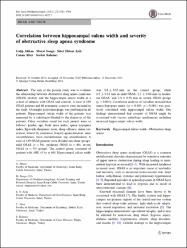Correlation between hippocampal sulcus width and severity of obstructive sleep apnea syndrome
Abstract
The aim of the present study was to evaluate the relationship between obstructive sleep apnea syndrome (OSAS) severity and the hippocampal sulcus width in a cohort of subjects with OSAS and controls. A total of 149 OSAS patients and 60 nonapneic controls were included in the study. Overnight polysomnograpy was performed in all patients. Hippocampal sulcus width of the patients was measured by a radiologist blinded to the diagnosis of the patients. Other variables noted for each patient were as follows: gender, age, body mass index, apnea hypopnea index, Epworth sleepiness scale, sleep efficacy, mean saturation, lowest O-2 saturation, longest apnea duration, neck circumference, waist circumference, hip circumference. A total of 149 OSAS patients were divided into three groups: mild OSAS (n = 54), moderate OSAS (n = 40), severe OSAS (n = 55) groups. The control group consisted of patients with AHI < 5 (n = 60). Hippocampal sulcus width was 1.6 +/- A 0.83 mm in the control group; while 1.9 +/- A 0.81 mm in mild OSAS, 2.1 +/- A 0.60 mm in moderate OSAS, and 2.9 +/- A 0.58 mm in severe OSAS groups (p < 0.001). Correlation analysis of variables revealed that apnea hypopnea index (rs = 0.483, p < 0.001) was positively correlated with hippocampal sulcus width. Our findings demonstrated that severity of OSAS might be associated with various pathologic mechanisms including increased hippocampal sulcus width.


















